Captain Herbert Haddock
- Oceanic
In 1907, Haddock was assigned to the RMS Oceanic - his Navy records list him as Master between the dates of 5.4.07 until 12.7.07 on the Liverpool to New York service. Shortly thereafter, the White Star Line moved its transatlantic service from Liverpool to Southampton and consequently, Haddock is listed as the Oceanic's captain for the next three years, from 17.7.07 - until March 1912, on the Southampton to New York route.
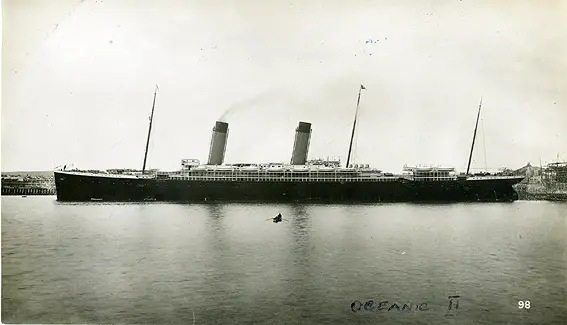
RMS Oceanic. (Click image to enlarge)
Launched in 1899, the Oceanic was the largest ship in the world until 1901 and at 17,272 gross tonnes was 704 ft (215 m) long and 68.4 ft (20.8 m) wide, powered by triple expansion reciprocating engines equalling 28,000 horsepower. Several officers who worked aboard the Oceanic would end up on Titanic - Charles Lightoller, David Blair, Herbert Pitman, Joseph Boxhall and James Moody.
His time as master of the Oceanic was not without incident. At 2am, Monday the 2nd of June 1907, only a few months into his tenure, a fire broke out in the unoccupied steerage area while the vessel was docked in New York between voyages. Haddock ordered crew down below to extinguish it and with help from the fireboat McClellan, the fire was under control by 2.45am, but the resulting damage totalled more than $10,000.
An Abstract of Log from the November 6th, 1907 voyage from Southampton to Cherbourg - Queenstown - New York" lists "Commander H.J Haddock, R.N.R, C.B." on a voyage that took 5 days, 19 hours and 43 minutes to travel 2,782 miles, an average speed of 19.91 knots.
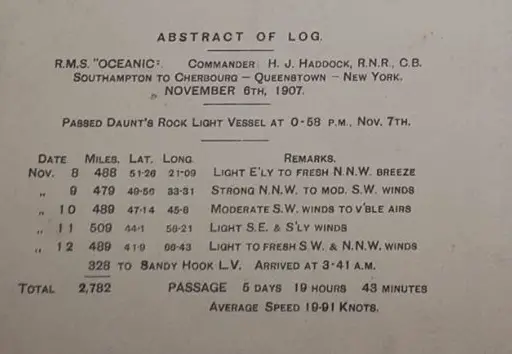
RMS Oceanic log, 6th November 1907. Image courtesy of Tony Cannings/www.ourwarwickshire.org.uk.
A first class passenger list from the 6 November 1907 voyage also allows a glimpse into life aboard the ship, with the following excerpts:
Senior Officers and Staff
Captain: H. J. Haddock (Cmdr., R.N.R.)
Surgeon: J. C. H. Beaumont
Purser: C. B. Lancaster
Assistant Purser: E. Whitehead
Chief Steward: W. Jones
(Source: gjenvick.com)
While notable Passengers are listed as: Georgianna Millington Bishop (an amatuer golfer), Lewis David Einstein (American diplomat and historian), Louise Kirkby Lunn (English contralto), Verner Zevola Reed (American capitalist and author).
Information for Passengers
Breakfast from 8 until 10 o'clock.
Luncheon at 1:00 pm
Dinner at 7 o'clock.
The Bar opens at 8:00 am, and closes at 11:00 pm
(Source: gjenvick.com)
Comparatively, another "Abstract of Log" from a voyage on the 22nd of April 1908 with Haddock as Captain shows they covered 2890 miles in 6 days, 2 hours and 27 minutes, arriving in New York at 9.52am at an average speed of 19.73 knots.
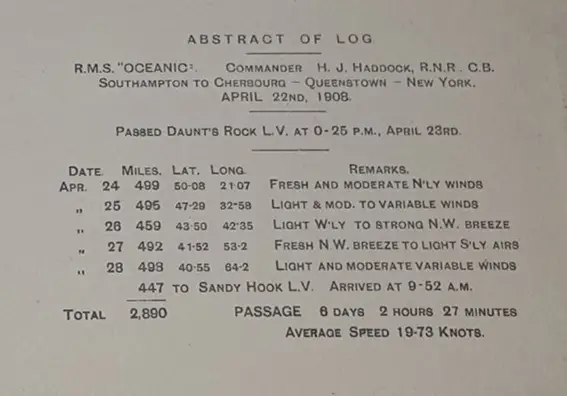
RMS Oceanic log, 22nd of April 1908. Image courtesy of Tony Cannings/www.ourwarwickshire.org.uk.
On Saturday the 2nd of January 1909, the Oceanic lost a propeller blade while Haddock was in command on a voyage from Southampton. It occurred while passengers were having dinner and caused noticeable trembling, forcing Haddock to immediately slow down. Their arrival into New York was further delayed by dense fog and she didn't reach New York until the 7th of January 1909.
On the 24th of November 1909, King Edward conferred officer's decorations of the British Royal Navy Reserve upon Haddock.
A December 8th, 1909 First class passenger list exists showing Haddock still in command.
Senior Officers and Staff
Commander: H. J. Haddock C.B., R.D. (Commr. R.N.R.)
Surgeon: J. C. H. Beaumont
Purser: C. B. Lancaster
Assistant Purser: J. H. M Smith
Chief Steward: W. Jones
Notable passengers are identified as Miss Marie Doro (an American stage actress and film actress, Hon. Sir Alexander Lacoste (Chief Justice of Quebec), Hon. Rodolphe Lemieux (Canadian parliamentarian), and most importantly, Mr. John P. Morgan, Jr., and Manservant along with Mrs. J. P. Morgan, Jr. , Miss Jane Norton Morgan, and Maid, Miss Frances T. Morgan and Master Henry Sturgis Morgan. This was not the famous (or infamous) JP Morgan himself, but his 43 year old son and family.
Haddock was allegedly publicity shy, however he did make two appearances in a December 1909 New York magazine with two relatively minor incidents, which if accurate, allow us some insight into his personality:
Exchanges of Courtesy 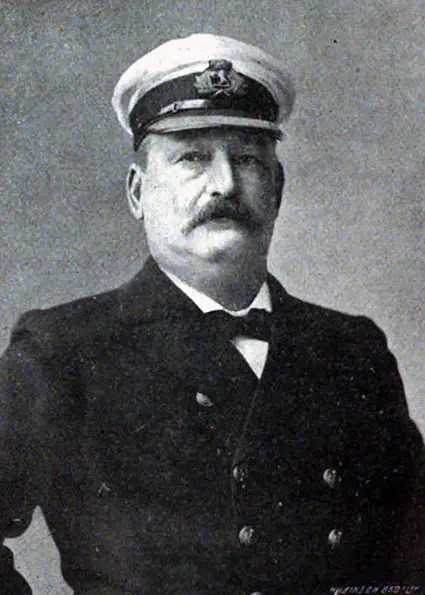 Captain John Pritchard, Cunard Captain and Chief, 1905 Master of the Campania, Carinthia, Saxonia, Ivernia, Lucania and Mauretania. In 1909, at the time the Sunday Magazine reported the friendship with Haddock, Pritchard was Commodore of the Fleet aboard the Mauretania. ("King of Captains" article, http://www.carnarvontraders.com/king.shtml) |
The following article serves as "an illustration of Haddock's all round cleverness." His many talents, due to having "two brains" includes "painting a picture of the sunset... fencing... translating a German recipe into French for the Oceanic's chef... a wireless operator."
Versatility of Captain Haddock |
1910 New Chelsea Piers
According to a New York Tribune newspaper article dated the 17th of February 1910, Haddock had "never had an accident at sea, but the company has planned a little make-believe collision for him on Monday" involving large ribbons of the "American and British colors stretched across the dock between piers No.s 58 and 59" for the Oceanic to break through. The article states that Haddock had been "made a Commander of the Bath in 1902, a commander of the Royal Naval Reserve in 1904 and recently King Edward conferred upon him the royal decoration for meritorious service." During Monday's pier opening ceremony "he will receive the title of C.I. and R.B., which according to the announcements, means chief ice and ribbon breaker of the new Chelsea piers." (New York Tribune, 17th of February 1910)
Later, on the 23rd of November 1910, Haddock was in command when the Oceanic struck a coal barge under tow during its arrival in New York. The captain of the barge and his wife were saved while the vessel sank in view of hundreds of Oceanic's passengers.
Then on Wednesday 23rd of March 1911, the Oceanic was caught in a storm during a Westbound crossing and was struck by lightning, splitting the ship's foremast into pieces which collapsed and narrowly avoided the bridge. First Officer Lightoller was apparently on the bridge at the time.
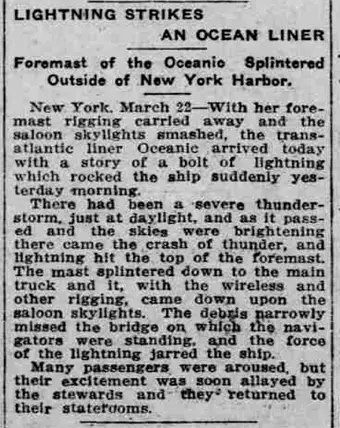
Newspaper article on lightning striking the Oceanic.
(Norwich Bulletin, March 23, 1911.)
It was not all smooth sailing on the Oceanic either, according to evidence given at the British Inquiry by Harold Arthur Sanderson, Director of the Oceanic Steam Navigation Company that Captain Haddock experienced issues with crew not wanting to comply with boat drill regulations:
We have experienced a very serious difficulty arising from the unwillingness of certain portions of the crew to comply with the Company’s regulations. To such an extent has that existed that they at times refuse duty on the voyage... I am particularly speaking of the firemen…think it is only within the last two years it has occurred. Up to that time we had no difficulty of the kind..The one I refer to was on the “Oceanic,” on a voyage to New York. The men refused duty on the voyage when ordered to a boat muster…I am not aware that there was anything more than a reluctance. They did not think it was fair to ask them to do it. Captain Haddock was in charge of the ship and he logged the men for not complying with orders, and there was so much friction about it that we decided to modify the orders and allow him to muster the men in New York instead of mustering them on the voyage, if that would make it easier to get the firemen to do it; and I believe, in fact, they have been mustering them in New York occasionally instead of mustering them on the voyage.
- Harold Arthur Sanderson, Director of the Oceanic Steam Navigation Company (British Inquiry)
On what would be Haddock's final crossing as master, the Oceanic once again lost a propellor blade on the 29th of February 1912, causing him to arrive one day late into New York.
Olympic Appointment
Talk of Haddock's appointment to commander of the Olympic began as early as December 1910, when several newspapers picked up on wireless messages to that effect.
Capt. Haddock to Have the Olympic and Hears of It by Wireless |
In June 1911, The New York Times carried the headlne "Capt. Haddock to Head White Star Line at Increased Pay" announcing that Haddock would relieve Captain Smith on his retirement to command the Olympic. The article described him as "a naval reserve commander, the only skipper in the Atlantic trade who wears the mid-Victorian mutton chop whiskers without a beard or mustache."
Capt. Haddock to Head White Star Line at Increased Pay |
In 1911 the Haddock family were living at number 40 The Avenue, Southampton. According to the 1911 Census, Mabel is living with their son Herbert and daughters Ruth and Joan, while Herbert Haddock senior is not listed - presumably because he is at sea at the time. Their oldest son Geoffrey is "boarding at Birkenhead School, Shrewsbury Road, Oxton, Birkenhead. Whilst here he was a prefect and played in the cricket and football teams." (Jackie Chandler/Southampton Cenotaph)
See also...
Next... Titanic